 1998 Callisto/Ganymede crater counts
1998 Callisto/Ganymede crater counts

 1998 Callisto/Ganymede crater counts
1998 Callisto/Ganymede crater counts

 Depth of Europa's ice crust: evidence
from circular features
Depth of Europa's ice crust: evidence
from circular features
 Europa's extremely young ice
rafts
Europa's extremely young ice
rafts
 1996 research results: cratering on
Ganymede, Europa, and Callisto
1996 research results: cratering on
Ganymede, Europa, and Callisto
 Other Galileo SSI released
images
Other Galileo SSI released
images
 Europa Ocean: the evidence from
pits
Europa Ocean: the evidence from
pits
 Galileo imaging research opportunities
at SwRI
Galileo imaging research opportunities
at SwRI
The counts shown in color are from the C10 transect of Asgard on Callisto. Larger craters are preferentially absent near the center of Asgard, but smaller craters are nearly as abundant as exterior to Asgard.
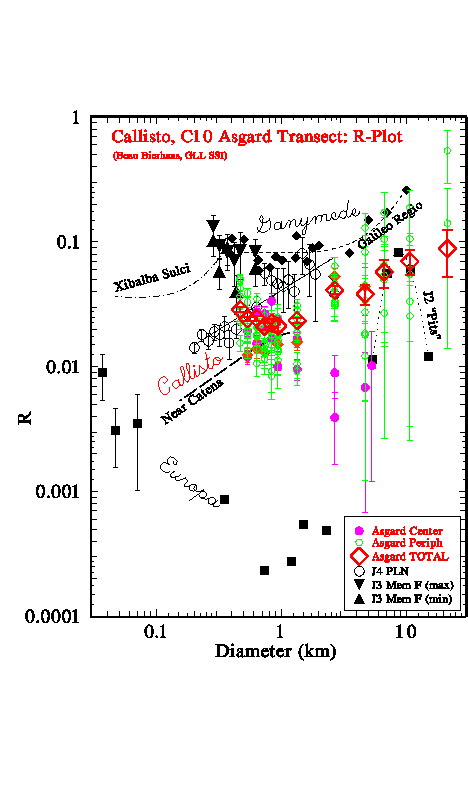
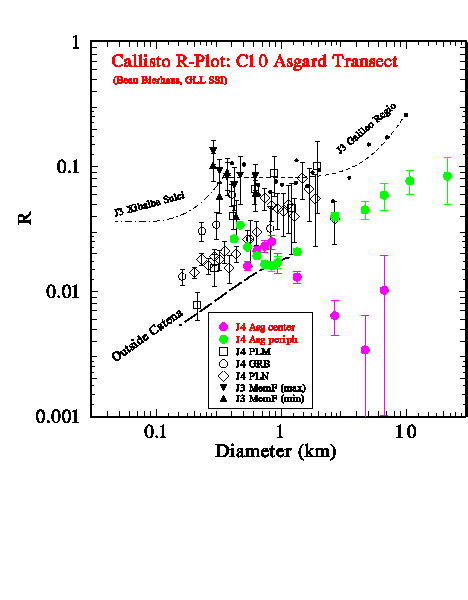
[Image: 3 Galileo crater images]
June 1997 Update: Europa's Extremely Young Ice Rafts
 Very Young Ages
AND/OR Few Small Comets: Analysis of Cratering of Europa and Other
Galilean Satellites (Meteoritical Society abstract)
Very Young Ages
AND/OR Few Small Comets: Analysis of Cratering of Europa and Other
Galilean Satellites (Meteoritical Society abstract)
 Impactor Populations on the
Galilean Satellites (1997 DPS abstract)
Impactor Populations on the
Galilean Satellites (1997 DPS abstract)
The "Age" of Europa: AGU Press Conference, 29 May 1997
Clark R. Chapman (Southwest Research Inst., Boulder)
 We have known since December that
Europa has surprisingly few craters on it. In particular, we learned
that 5-10 km depressions are actually collapse features rather than
impact craters and that there are very few craters of roughly
1 to 3 km diameter on Europa.
We have known since December that
Europa has surprisingly few craters on it. In particular, we learned
that 5-10 km depressions are actually collapse features rather than
impact craters and that there are very few craters of roughly
1 to 3 km diameter on Europa.
 In the "ice rafts" terrain, we discovered even
fewer craters (hundreds of meters diameter), especially in the "matrix"
in which the rafts appear to float.
In the "ice rafts" terrain, we discovered even
fewer craters (hundreds of meters diameter), especially in the "matrix"
in which the rafts appear to float.
 Based on Gene Shoemaker's Jupiter family
comet flux, and using a reasonable (but possibly very wrong)
extrapolation from observations to comets 1% as big, the "age" of the
disrupted terrain is ~3 m.y.
Based on Gene Shoemaker's Jupiter family
comet flux, and using a reasonable (but possibly very wrong)
extrapolation from observations to comets 1% as big, the "age" of the
disrupted terrain is ~3 m.y.
 We have recently discovered that at least
2/3rds of the craters are actually secondary craters from the Pwyll
impact; discounting those, the age is about 1 m.y.
We have recently discovered that at least
2/3rds of the craters are actually secondary craters from the Pwyll
impact; discounting those, the age is about 1 m.y.
 Pwyll (which would be made by a comet
roughly the size of Shoemaker-Levy 9) is probably the most recent
Europan crater of that size, and one should form every million years,
or so. There are indications, but not proof, that Pwyll was formed
contemporaneously with the ice rafts terrain.
Pwyll (which would be made by a comet
roughly the size of Shoemaker-Levy 9) is probably the most recent
Europan crater of that size, and one should form every million years,
or so. There are indications, but not proof, that Pwyll was formed
contemporaneously with the ice rafts terrain.
 There are indications that small comets may
be fewer than estimated by the extrapolations (e.g. few broken-up
small-comet S-L 9-like crater chains); ages would then be
older.
There are indications that small comets may
be fewer than estimated by the extrapolations (e.g. few broken-up
small-comet S-L 9-like crater chains); ages would then be
older.
 Taking everything into account, I estimate
the age of the ice-rafts terrain is probably not much less than 1 m.y.
nor older than 100 m.y. -- very young compared with Europa's
age, and indicating that Europa's resurfacing processes are currently
operating today.
Taking everything into account, I estimate
the age of the ice-rafts terrain is probably not much less than 1 m.y.
nor older than 100 m.y. -- very young compared with Europa's
age, and indicating that Europa's resurfacing processes are currently
operating today.
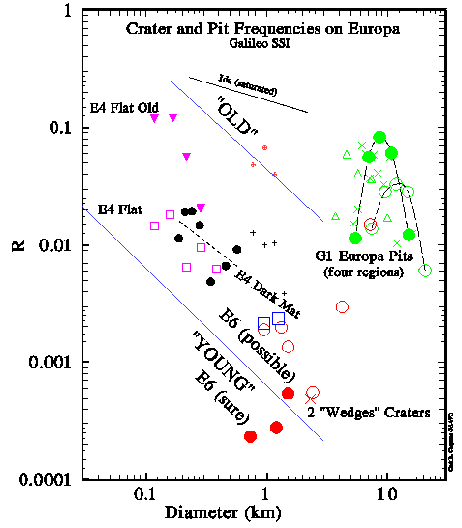
R-plot of crater densities on Europa shows low density for 2 craters on "wedges" frame (red X) and even lower densities for craters on E6 terrains (solid red dots). Counts on ice rafts terrains fall near the "E" in the label "E6 (sure)".
(image of ice rafts)
Portion of the E6 "ice rafts" terrain on Europa at moderately high resolution.
The Galileo spacecraft, which has orbited Jupiter since December 1995, was not designed to find life, although the late Carl Sagan found evidence of life on one planet encountered by Galileo: Earth! Galileo's camera and spectroscopic instruments can define a body's geology and measure its surface environment. It is less easy to extrapolate Galileo's findings about a body's surface to decipher its subterranean environments.
Galileo's sixth satellite encounter was a February flyby a few hundred miles above Europa's surface. Earlier pictures of Europa showed perplexing criss-crossing ridges but nothing that clearly said "there's water below." This time, focussing on a reddish-brown "spot" on Europa's disk, high-resolution images revealed an all-too- familiar landscape...familiar, that is, to explorers of the arctic zones of Earth. For example, Max Coon of Seattle, a veteran of arctic ice fields north of Alaska, looked at pictures of Europa's floating ice rafts and was immediately sure: Europa is covered with an icy crust a kilometer or two thick, atop a watery ocean.
Habitable zones seem increasingly to be common. Until recently, we thought the sun had a narrow habitable zone -- Earth is luckily within it, but Venus is too close to the sun and Mars too far away to sustain life. Now, Europa exemplifies that a planetary system can have a wider diversity of clement climates. Indeed, Europa has all the ingredients for life: a continuing supply of organic compounds from impacting comets and a "warm" ocean, as well. Galileo's discovery reinforces other evidence (possible fossil life in a Martian rock and ever-increasing numbers of planets around other stars) suggesting that the universe may be replete with habitable niches. Now it remains to learn whether life actually evolves in them.
Europa's landscape is remarkably flat. Despite a complex array of landforms, few of Europa's ridges, mounds, or collapsed depressions have vertical relief exceeding a couple hundred meters. Indeed, the flatness of Europa's surface is reminiscent of the north polar expanses on Earth.
Impact craters are common on most planetary surfaces but rare on Europa. That tells us something important. Europa's icy volcanism, ridge formation, and ice rafting MIGHT have occurred aeons ago, and then frozen into a tableau of that ancient surface...EXCEPT for the lack of craters. We know that comets careen past Jupiter and some must crash onto Europa. Indeed, just three years ago, we witnessed the spectacular demise of 20 fragments of the comet Shoemaker-Levy 9 when they struck Jupiter. They might just have well hit Europa, just as crater chains on Ganymede and Callisto suggest happened to those bodies. Many craters must form on Europa, but active geological processes must be erasing them as rapidly as they form. I estimate that the ice rafts are floating in a region that solidified just a million years ago. Other parts of Europa, not examined yet, must be active today. We may yet see a plume from temporarily exposed water on Europa before Galileo's Europa- intensive studies end two years from now.
How can water exist where the sun's warmth is just a few percent of what we are accustomed to on Earth? If Europa formed hot, or was heated by decaying radioactivity like the Earth, how can such a small body have avoided the rapid cooling and geological death billions of years ago, like happened on our own Moon?
The probable answer was understood in the late 70's as the first Voyager spacecraft approached Jupiter. California theoreticians Pat Cassen, Ray Reynolds, and Stan Peale reasoned that the tidal wrenchings by Jupiter of the first three Galilean satellites, which are trapped in orbital resonances, would heat Io dramatically. Their prediction of active Ionian volcanoes was almost immediately confirmed. Lost in that excitement was the possibility that Europa, though heated less than Io, might be warmed enough by tides to maintain an ocean. (Surficial ice on Europa was discovered in the early 1970's by telescopic infrared spectroscopy.)
Subsequent thermal calculations of Europa's evolution were ambiguous: some supported an ocean while others indicated that any ocean would have frozen long ago, despite tidal heating. Only with Galileo's revelation of the extraordinary youth of Europa's surface and pictures of kilometer-thick ice rafts, twisted and tipped by convecting currents below, can we be confident that a Europan ocean is being maintained today.
It will be challenging, indeed, to deploy machinery to puncture through the thinnest regions of Europa's crust and perform the oceanographic explorations that may ultimately answer the second question about extraterrestrial life: do natural processes yield life when hospitable conditions are present?
(Image: portion of wedges frame)
Portion of the C3 "wedges" frame of Europa showing only one crater larger than 2 km diameter.
The first third of Galileo's orbital tour of the Galilean satellites has provided images with much better resolution than Voyager. Because of the fragmentary return so far (e.g. contextual frames for high-resolution images are scheduled for future orbits), it is premature to fully assess the distributional and stratigraphic correlations (e.g. any apex/antapex variations) of crater populations and spatial densities. This work studies the "snapshots," on various terrains, of crater size-frequency and morphology statistics at scales ranging from 50 m (in one case) to greater than 10 km which provide insight about the geology and impact history of the satellites, even as the data continue to guide selection of imaging parameters for the remainder of the mission.
We present preliminary crater counts for various terrains on Ganymede (including Uruk Sulcus, Galileo Regio, and the "unnamed sulcus"), Europa, and the Valhalla region of Callisto. A single generalization is that craters less than several hundred m diameter are unexpectedly underabundant, never approaching saturation densities even on the terrains of Ganymede and Callisto that appear saturated by large craters. In detail, the processes that have degraded and/or erased small craters vary rather remarkably from satellite to satellite and on the different terrains of each. While we presume that roughly the same impactor population is responsible for most cratering on the three satellites, the relative importance of secondary cratering and of Shoemaker-Levy-9-like comet fragments remains to be learned. We present evidence that many 6-15 km diameter pits on Europa may not be impact craters (instead they may be collapse features, for example)[2].
Differential diameter-frequency relations are presented in Fig. 1 in the "Relative Plot" format [1], where height on the plot indicates spatial density of craters and unity is geometric saturation (never practically achieved on real surfaces; the curve for Ida that is shown approaches practical limits R�0.3).
Cratering on Europa. Craters and pits in global and medium-resolution G1 and G2 (first two orbits) images of Europa show that its surface is relatively very youthful. Voyager conclusions [3] that large craters are very rare are sustained. There is a spatially non-uniform population of pits (first seen by Voyager, with hundreds more now seen in Galileo's G1 near-terminator images), which have diameters around 9 km. The mono-modal size distribution of the pits (Fig. 1) and a spatial avoidance of pits and lineaments imply that most pits are not of impact origin. Many may be collapse features. A C3-orbit image centered on wedge-like features (with 0.4 km resolution) shows only two impact craters greater than 2 km diameter in a 50,000 sq km region. Although this region may be young, the two craters cannot be due to a plausible power-law- like projectile population that would also have produced the vastly more numerous pits seen in G1 images, unless one or both regions are exceptionally anomalous; this again implies that the pits are not impact craters. Even the somewhat more heavily cratered regions imaged at high resolution during orbit E4 would be 100 times younger than pitted terrains (assuming they are primary craters following a typical power-law production function and assuming constant cratering rate) if the pits are impact craters. Inferences [4] from the pits that numerous, somewhat larger craters have viscously relaxed away and provide evidence for the thickness of an ice layer atop a Europan ocean, would be invalidated if most pits are not of impact origin. Large craters may well have viscously relaxed, but there are not many of them.
Higher resolution E4-orbit images show variable -- but generally low -- densities of small (few hundred m) craters; they appear to be impact craters (either primary or secondary). They do not exhibit a full range of degradational states, suggesting that the processes that remove small craters do so relatively suddenly (e.g. by local tectonic or flooding processes); several craters appear to be partly overlapped by endogenic features (ridges or flow fronts). A high-resolution image of a feature that looks like a 6 km diameter pit in moderate resolution contextual images reveals it to be an irregularly shaped, tectonically controlled depression unrelated to an impact.
Cratering on Ganymede. The Uruk Sulcus grooved terrains are cratered at sizes <1 km with a relatively steep size distribution (differential power law index ~-4); spatial densities are similar to those observed on Gaspra, distinctly less than saturation. Such crater densities vary by factors of a few on adjacent units, but are confused by superimposed clusters of craters. One cluster, possibly secondaries associated with a large crater to the southwest, has craters with diameters in a narrow size interval, 0.5 to 2 km, unlike the very steep power-law populations usually associated with secondaries; possibly this observation is related to a general absence of evidence of ejecta from many craters on Ganymede.
Galileo Regio is characterized by a high density of large craters (several km in diameter and larger), but the processes (tectonic and otherwise) that have so severely degraded them has likewise swept the slate clean for recratering by a modest population of smaller craters, similar to that expressed on Uruk Sulcus. Indeed, at smaller spatial scales, Galileo Regio is no older than the older terrains of Uruk Sulcus.
The unnamed sulcus, imaged at 11 m/pixel, is remarkably devoid of small craters, despite numbers of several-hundred-m diameter craters that are similar to the other studied terrains on Ganymede. The small craters are mostly fresh, hence they are not being diminished by continuous degradational processes. A combination of relative youth and a shallow-sloped production function at small sizes may explain the unexpectedly low crater density; we await later contextual images of this region.
Cratering on Callisto. Despite having a surface nearly saturated with large craters, the localities of Callisto imaged at high resolution so far, generally in the Valhalla region, are covered with a pervasive blanket of apparently erosional debris that has filled in much of the larger-scale topography and created relatively young surfaces (similar to the youth of Europa) for small-scale cratering. A spectrum of morphologies among the small craters implies that the process that is creating the gently rolling plains on Callisto is acting fairly continuously. The larger (multi-km) craters are disappearing both due to infilling by the blanketing material as well as by in situ disaggregation and mass-wasting of the crater walls [5, 6]. Comparisons of crater counts inside and exterior to Golum Catena may indicate a production population undergoing continuing degradation within the comparatively recent feature, while remnants of larger, older disaggregating craters add to the counts exterior to the catena. The larger (~1 km) crater remnants are most numerous on the Valhalla graben image, of the high resolution Callisto data acquired so far.
Inter-satellite Comparisons and Ages. 100-m scale craters are rare (R~1-3%) on all terrains imaged at high- resolution so far, on all three satellites. Until there is better information about the size distribution of impactors in the Jovian environment (especially of sizes that make sub-km craters), it is difficult to disentangle the possibility that most satellite surfaces (at these scales) are unexpectedly young from the possibility that small comets and other impactors are unexpectedly depleted as compared with simple extrapolations from larger sizes. We hope to learn more about the absolute impact rates, but for the moment they remain very poorly known. Possibly we are witnessing a record of an intense early bombardment, with very low subsequent impact rates, in which case most units (except those on Europa that are almost wholly devoid of craters) could be quite old. Alternatively, if much of the cratering record has been established at a relative constant impact rate, then many of the surfaces could be subject to various on-going processes that renew them (at scales of tens to hundreds of meters) on time scales of tens to hundreds of millions of years, making the Galilean satellites even more geologically "active" than had been supposed based on Voyager data. The degradational and resurfacing processes show various styles, ranging from discontinuous ridge-forming processes on Europa to continuous landform degradation on Callisto.
References: [1] Crater Analysis Techniques Working Group (1979) Icarus 37, 467-474. [2] C.R. Chapman, W.J. Merline, B. Bierhaus, S. Brooks, & J. Keller (1996) Presentation at Europa Ocean Conf., San Juan Capistrano CA, Nov. 12-14 (abstract booklet, p. 19). [3] M.C. Malin & D.C. Pieri (1986) In Satel- lites (ed. J.A. Burns & M.S. Matthews, U. Ariz. Press), 689-717. [4] E.M. Shoemaker (1996) Europa Ocean Conf., San Juan Capistrano CA, Nov. 12-14 (abstract booklet, p. 65). [5] K.C. Bender et al. (1997) LPSC XXVIII, submitted abstract. [6] J. Moore et al. (1997) LPSC XXVIII, submitted abstract.
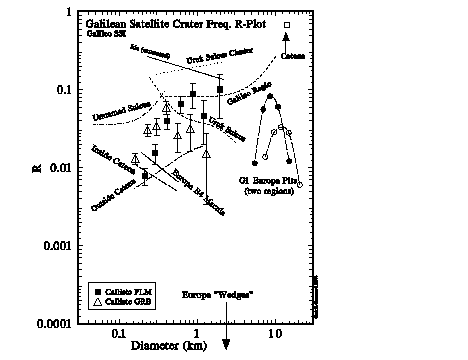
Fig. 1. R-plot (differential frequencies divided by D exp[-3]) of preliminary crater counts on Europa, Ganymede, and Callisto. Representative data with error bars are shown for two localities on Callisto imaged at high-resolution during the C3 encounter. Other counts are represented by curve fits. Arrows point to single data points for the two isolated craters on the Europa "wedges" C3 image and for the three Gomul Catena craters shown in a Callisto image sequence.
Cratering on Ganymede: Preliminary Galileo G1 Results
Abstract for 1996 DPS Meeting
(Image of Uruk Sulcus)
Portion of Galileo Regio imaged by Galileo SSI during G1 encounter. Resolution about 75 meters/pixel. Crater counts shown below are for this region (approximately). Below that are counts for the Uruk Sulcus region (picture at top of this page).
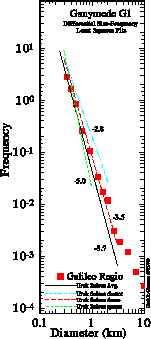
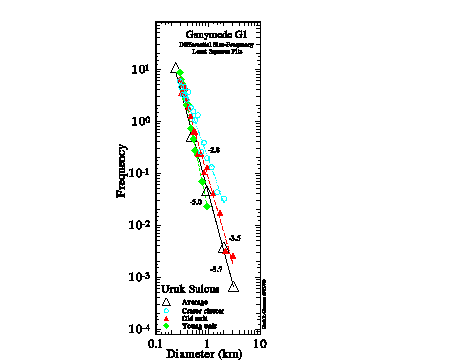
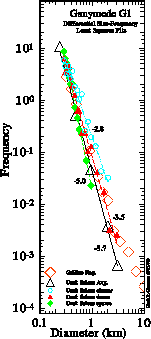
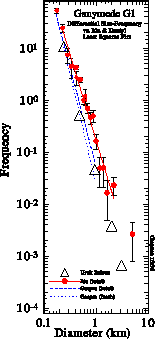
|
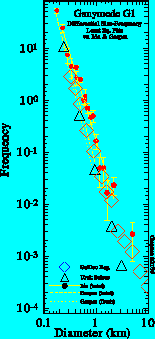
|
(image of Io and volcanic plume)
(image of Red Spot)
(image of Europa map)
For the complete page with SSI images, click here for text, graphs, and IMAGES.
Southwest Research Inst. (#426, 1050 Walnut, Boulder CO 80302)
The Galileo mission, and proposed Galileo Europa Mission, will obtain extremely detailed images of Europa that will permit a quantum jump over the Voyager flybys in our understanding of the geology of Europa and of its cratering record, in particular. The first substantial improvement over Voyager in imaging resolution was obtained on Nov. 6, 1996, during Galileo's 3rd orbit; these images will be played back in early December (following this conference). Further improvement in resolution by an additional factor of ~15 will be obtained during targeted Europa encounters later in the mission. Despite the fact that higher resolution Europa data have not yet been obtained and/or returned, distant images of Europa taken during Galileo's first orbit (G1, around the time of the first Ganymede encounter) already have slightly better resolution than Voyager. Combined with better image quality, different areal coverage, and improved discriminability from additional filters, the G1 Europa images provide a noticeably better view of the craters, pits, and depressions that were discussed by earlier Voyager researchers (1).
A primary issue, raised by Voyager images, concerns the apparent youth of Europa's surface and any implications from the crater densities and morphologies concerning the nature of Europa's surface and subsurface (e.g. the thickness of an ice crust floating on water [2]).
The Galileo images have confirmed the impressions of Lucchitta and Soderblom (3) that there are a few (but only a few) large impact craters. In particular, Belton et al. (4) have noted an apparent crater 30 km in diameter. Belton et al. also call attention to ray features that appear to emanate from a feature poorly resolved in Voyager imagery. New coverage of those longitudes during Galileo's second (G2) orbit confirm that the Voyager feature is a prominent ray crater. In these, and nearly all other, cases of large craters, however, we have no evidence that they remain expressed as craters topographically. The craters discussed by Belton et al. are stratigraphically youthful, in the sense that their rays overlay adjacent triple bands, but they provide no information on the rigidity or thickness of Europa's crust - - only on the relative duration of the photometric expression of ejecta patterns (rays).
In addition to the large craters, near-terminator portions of Galileo Europa images show hundreds of smaller craters, pits, and depressions. Almost all of them have relatively low relief, compara- ble with ridges in the same regions. We classify these features into three groups: (a) a small number of apparent impact craters, with characteristic raised rims and relatively fresh morphology; (b) shallower quasi-circular pits and depressions which may (or may not) be degraded impact craters; and (c) irregular depressions, sometimes spatially grouped with other depressions, which may be secondary impact craters or endogenic formations, but which are unlikely to be degraded primary impact craters.
The largest of these pits are about 20 km across. Most of them are between 5 and 10 km across. Our preliminary impression is that total ensemble of these features has a preferential size and does not follow a size distribution that connects with the larger craters or extends to smaller craters with the same size distribution expressed on Ganymede. It is possible that the shallow morphology hinders recognition of features <5 km in diameter, near the resolution limit of the G1 Europa frames. The images of Europa just acquired during the third orbit (C3) and scheduled for playback in December should quickly resolve ambiguities about the numbers of smaller features. However, these impressions of the crater size-frequency characteristics would be in accord with most of the pits (other than the obvious impact craters) being not of primary impact origin. Should later data reveal larger numbers of smaller craters, then the data would be consistent with a process (like viscous relaxation) that suppresses the recognizability of large-scale topography but retains small features.
Additional attributes of the population of pits also call into question the hypothesis that more than a small percentage of them are of impact origin. We have attempted to understand where the smaller pits and craters fit into the complex stratigraphy of the overlapping bands, ridges, and other lineaments. That is, are the pits generally older than the lineaments, or do they generally cross-cut the lineaments? Neither is clearly true. In fact, the pits and lineaments seem to avoid each other. Given the prevalence of both pits and lineaments in many near-terminator regions, it is surprising how rarely lineaments cross pits or are overlapped by pits. In some cases pits are adjacent to lineaments, occasionally at points where lineaments actually change direction. But overlapping relationships are rare. This could be consistent with a population of impact craters that is older than most of the lineaments, if impact craters modify surface materials in ways that would inhibit propagation of linea- ments across the impact features. It might also be consistent with populations of endogenic craters, either older or younger than the lineaments (again supposing that the formation processes mitigate against one type of feature being formed on top of the other). But the observation is incompatible with a youthful population of impact craters, which should not avoid occasionally overlapping ridges and bands.
Finally, we note wide variations in the spatial densities of the pits. In some small provinces, often bounded by lineaments, pits and craters are absent. In others, the spatial density is quite high and, in a few locations, possibly approaching saturation densities. In a few regions, we see unbounded regions in which pits and lineaments seem to have been erased by some very recent flow-like process. The areas so affected are too small to place statistically robust limits on youthfulness, but they remind us that there probably are ongoing processes that form new, featureless units on the surface of Europa.
Until later, higher resolution images resolve what fraction of craters on Europa are of impact origin, we think it is premature to conclude (as Shoemaker [this meeting] does) that viscous relaxation is operating on Europa. If the smaller craters are degraded primary impacts, then they are probably old, viscous relaxation may be occurring, and the lineaments are relatively young. If, on the other hand, the smaller craters are primarily of endogenic origin, then Europa's surface is also relatively young.
Assigning an absolute chronology to Europa's youth, however, is difficult because we have no knowledge of the numbers of the active or extinct comets (or other impactors) of the small sizes that would make the small craters we see. Various existing evidence (steep size distribution of craters on Ganymede, break-up of Comet Shoemaker-Levy 9, knowledge of small-comet populations and cratering statistics in the terrestrial planet region, etc.) provides, as yet, no firm basis for estimating the cratering rates in the Jovian system.
In conclusion, the prevalence of craters and pits on early Galileo images of Europa does nothing to change earlier Voyager- based conclusions about the relative youth of Europa's surface. Nor does it affect the potential validity of earlier speculations that Europa's icy crust may be quite thin. But it doesn't prove it, either.
References:
(1) Malin, M.C. and Pieri, D.C. (1986). Europa. In Satellites (ed. J. A. Burns and M.S. Matthews, Univ. Ariz. Press, Tucson) 689-717.
(2) Shoemaker, E.M. and Wolfe, R.F. (1982). Cratering time scales for the Galilean satellites. In Satellites of Jupiter (ed. D. Morrison, Univ. Ariz. Press, Tucson) 277-339.
(3) Lucchitta, B.K. and Soderblom, L.A. (1982). The Geology of Europa, in Satellites of Jupiter (ed. D. Morrison, Univ. Ariz. Press, Tucson) 521-555.
(4) Belton, M.J.S. et al. (1996). Galileo's first images of Jupiter and the Galilean satellites. Science 274, 377-385.
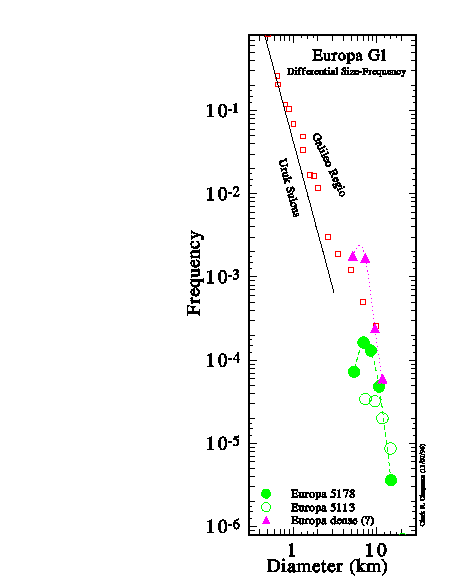
Clark R. Chapman, W. Merline, B. Bierhaus, J. Keller, S. Brooks (Southwest Research Inst., #426, 1050 Walnut, Boulder CO 80302 USA); J. Head, R. Pappalardo (D. Geol. Sci., Brown U., Providence RI 02912 USA)
Craters and pits in medium-resolution images of Europa obtained early in the Galileo orbital mission show that Europa's surface is relatively very youthful. There is a spatially non-uniform population of pits (first seen by Voyager and hundreds seen in Galileo's G1 orbit images), having diameters within a factor of 2 of 8 km. The mono-modal size distribution and a spatial avoidance of pits and lineaments imply that most pits are of endogenic origin (e.g. collapse pits). A C3-orbit image centered on wedge-like features (with 0.4 km resolution) shows only two impact craters >2 km diameter in a 50,000 sq. km region. Unless this region is very anomalous, the two craters cannot be due to a plausible projectile population that would have produced the pits seen in G1 images, again implying that the pits are not impact craters. If the relatively youthful Uruk Sulcus region on Ganymede dates from after a heavy early bombardment period, then the nearly 2-orders-of-magnitude fewer craters in the wedge image implies a crater retention age younger than 30 m.y. Despite major uncertainties in the size-distribution and impact flux history of impactors that make 2 km size craters, Europa's surface is clearly very young and resurfacing is probably an ongoing process.
This past autumn, I was advertising for undergraduates, graduate students, and post-docs who might be interested in working with me on Galileo research. As of mid-October, those positions were filled. But if you have a potential future interest in working at SwRI's Boulder office, click the next button.
 More
information about research opportunities at SwRI's Boulder Office
More
information about research opportunities at SwRI's Boulder Office
 Back to Top of this Galileo Page.
Back to Top of this Galileo Page.
 Clark
R. Chapman's Publications.
Clark
R. Chapman's Publications.
 Return to Clark R. Chapman's
Home Page
Return to Clark R. Chapman's
Home Page
 Homepage
Homepage